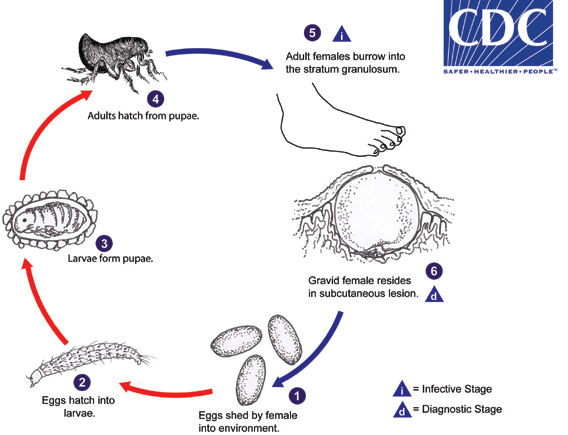Introduction to Diagnostic Medical Parasitology
Essentials

-
Gravid female Tunga penetrans release their eggs into the surrounding environment.
-
These eggs hatch into larvae within approximately 3-4 days, and these larvae feed on organic matter in their environment.
-
Tunga penetrans undergo two larval stages before transitioning into pupae. These pupae are enclosed in cocoons, often covered with environmental debris like sand or pebbles.
-
The larval and pupal stages collectively take about 3-4 weeks to complete. Once mature, adults emerge from the pupae.
-
These adult fleas actively seek out warm-blooded hosts for blood meals. Both males and females feed intermittently on their hosts, but only mated females burrow into the host's skin (epidermis), causing the formation of nodular swellings.
-
The female fleas lack specialized burrowing structures and use their mouthparts to attach and claw into the host's epidermis. After penetrating the stratum corneum, they burrow into the stratum granulosum, leaving only their posterior ends exposed to the environment.
-
Female fleas continue to feed, and their abdomens can extend up to about 1 cm. During a two-week period, females lay approximately 100 eggs before eventually dying and being shed from the host's skin. Tungiasis can lead to secondary bacterial infections, which are not uncommon.
Epidemiology
- Tunga penetrans is found in tropical and subtropical regions worldwide, spanning from Mexico to South America, the West Indies, and Africa.
- These fleas typically inhabit sandy environments, such as beaches, stables, and farms.
Pathology
The females of the sand flea live on the ground and, upon contact with a host, burrow into its skin. Typically, the feet are affected, followed by the backs of the hands and elbows. In endemic areas, cases with hundreds of entry points can occur, particularly among individuals who regularly sleep on the ground in close proximity to livestock (such as goats, sheep, cattle, but especially domestic pigs).
Clinical Findings
On the skin, there is an itchy, painful bump with a central black spot. The surrounding area exhibits varying degrees of inflammation in different individuals. The hindgut and reproductive organs of the sand flea protrude centrally from the bump, allowing it to deposit eggs and excrement in the surrounding environment. As the condition progresses, the bump is typically covered by a dark crust. The flea dies after approximately 2 to 3 weeks, and the wound heals, often leaving a scar.

Diagnosis
The diagnosis in a laboratory setting involves identifying the presence of adult fleas and their eggs within the affected areas or lesions.
Prevention and control
- Wearing closed-toe shoes.